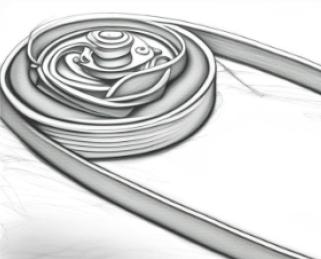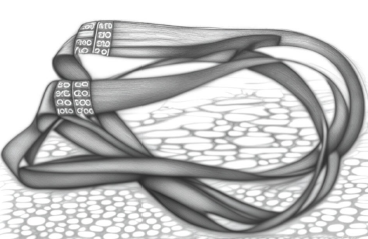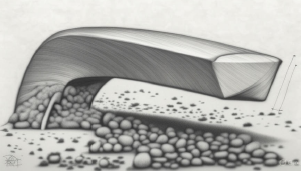
~~~ La versione in italiano inizia subito dopo la versione in inglese ~~~
ENGLISH

24-10-2025 - Applied Mechanics - Belts [EN]-[IT] With this post, I would like to provide a brief introduction to the topic in question. (lesson/article code: EX_LZ_51)

Image created with artificial intelligence, Grok software used
Introduction Belts are flexible components used to transmit power between two pulleys. Their popularity is due to the fact that they are inexpensive, elastic, and tolerate modest misalignment.
Factory and positive coupling (advantages/disadvantages)

Image created with artificial intelligence, the software used is Grok
Factory coupling Factory couplings occur with flat and V-belts. Advantages They operate smoothly, i.e., silently, absorb overloads, have high permissible speeds, and do not require lubrication. Disadvantages Among the disadvantages are that the transmission ratio is not strictly constant (causing slippage), and they are not suitable for low speeds (≈1–2 m/s, except for low power outputs). Factory fit Factory fits occur with chains and timing belts. Chains transmit high forces at low speeds, but become noisy at high speeds, wear rapidly, and require lubrication. Timing belts allow for precise timing and do not require lubrication. They can be used to design fast and quiet transmissions.
Main characteristics of flat belts

Image created with artificial intelligence, Grok software used
Flat belts are low-cost and suitable for large center distances and winding paths. They can operate in harsh environments, are highly flexible, and are efficient at high speeds. Finally, flat belts absorb even violent torque variations. However, they have limitations, such as the possibility of slippage, noise, modest efficiency at low speeds, and high bearing loads.
Main characteristics of V-belts

Image created with artificial intelligence, software used: Grok
V-belts are quiet, allow for high gear ratios, have a medium purchase cost, and require little maintenance. They also absorb torque variations well, are easy to install, and have a good lifespan. However, they do not allow for precise timing between the drive and driven shafts.
Main Features of Timing Belts

Image created with artificial intelligence, Grok software used
Timing belts eliminate slippage and are quiet with excellent efficiency. Another important feature is that they allow for very small pulley diameters and high ratios with minimal space requirements.
Analytical expression of the tension variation in the flexible hose wound on a pulley From the equilibrium of the belt element on the sliding arc, we obtain

Where: T = Total tension f = Friction factor θ = Angle along the arc m = Mass per unit length v = Belt speed
By performing the various transformations, we arrive at the practical relation for the tension of the taut branch, which is:

Where: T1 = tension in the taut section T2 = tension in the slack section m = linear mass of the belt v = linear speed of the belt f = friction factor between the belt and the pulley on the sliding arc θs = angle (in radians) of the sliding arc
Conclusions We can conclude by saying that a force coupling (flat/V-belts) is chosen if flexibility and damping are required, while a form coupling (timing belts/chains) is chosen if synchronization is required. The ability to transmit torque on power belts is governed by T1, T2, f, θs and decreases as v increases due to the centrifugal effect.
Question Did you know that the invention of V-belts is attributed to American John Gideon Gates (1884-1969)? Did you know that the first V-belt (also called a V-belt) was developed in 1917 by the Gates Rubber Company?

ITALIAN

24-10-2025 - Meccanica Applicata - Cinghie [EN]-[IT] Con questo post vorrei dare una breve istruzione a riguardo dell’argomento citato in oggetto (codice lezione/articolo: EX_LZ_51)
[IMMAGINE]
immagine creata con l’intelligenza artificiale, il software usato è Grok
Introduzione Le cinghie sono organi flessibili che servono per trasmettere potenza tra due pulegge. La loro diffusione è dovuta al fatto che sono economiche, elastiche e tollerano disallineamenti modesti.
Accoppiamento di forza e di forma (vantaggi/svantaggi)

immagine creata con l’intelligenza artificiale, il software usato è Grok
Accoppiamento di forza Gli accoppiamenti di forza avvengono con cinghie piane e trapezoidali. Vantaggi Hanno un funzionamento dolce, cioè silenzioso, assorbimento dei sovraccarichi, velocità ammissibili elevate, non necessitano di lubrificazione. Svantaggi Tra gli svantaggi abbiamo che il rapporto di trasmissione non è rigorosamente costante (causa slittamento), non adatte a basse velocità (≈1–2 m/s, salvo piccole potenze) Accoppiamento di forma Gli accoppiamenti di forma avvengono con catene e cinghie dentate. Le catene trasmettono forze elevate a basse velocità, ma diventano rumorose ad alta velocità, hanno un usura rapida e richiedono lubrificazione Le cinghie dentate consentono fasature precise e non richiedono lubrificazione. Con esse si possono progettare trasmissioni veloci e silenziose
Caratteristiche principali delle cinghie piane

immagine creata con l’intelligenza artificiale, il software usato è Grok
Le cinghie piane hanno un costo basso e sono adatte a grandi interassi e percorsi tortuosi. Possono lavorare in ambienti sfavorevoli, sono molto flessibili ed efficienti ad alte velocità. Infine le cinghie piane assorbono variazioni anche violente di coppia. Esse hanno però dei limiti come la possibilità di slittamento, la rumorosità, il rendimento modesto alle basse velocità e un carico elevato sui cuscinetti.
Caratteristiche principali delle cinghie trapezoidali

immagine creata con l’intelligenza artificiale, il software usato è Grok
Le cinghie trapezoidali sono silenziose, consentono elevati rapporti, hanno un costo d’acquisto medio e una manutenzione ridotta. Inoltre assorbono bene le variazioni di coppia, hanno un esecuzione di montaggio semplice e una buona durata. Hanno però lo svantaggio che non permettono la fasatura precisa tra albero motore e condotto.
Caratteristiche principali delle cinghie dentate

immagine creata con l’intelligenza artificiale, il software usato è Grok
Le cinghie dentate eliminano lo slittamento e sono silenziose con ottimo rendimento. Un altra caratteristica importante è che permettono pulegge di diametro molto piccolo ed elevati rapporti con minimo ingombro.
Espressione analitica della variazione di tensione nel flessibile avvolto su una puleggia Dall’equilibrio dell’elemento di cinghia sull’arco di scorrimento si ottiene

Dove: T= Tensione totale f = fattore d’attrito θ = angolo lungo l’arco m = la massa per unità di lunghezza v = la velocità della cinghia
Eseguendo le varie trasformazioni arriviamo alla relazione pratica della tensione del ramo teso che è:

Dove: T1 = tensione del ramo teso T2 = tensione del ramo lasco m = massa lineare della cinghia v = velocità lineare della cinghia f = fattore d’attrito tra cinghia e puleggia sull’arco di scorrimento θs = angolo (in radianti) dell’arco di scorrimento
Conclusioni Possiamo concludere dicendo che si sceglie l’accoppiamento di forza (cinghie piane/trapezoidali) se serve flessibilità e smorzamento, invece quello di forma (cinghie dentate/catene) se serve sincronismo. La capacità di trasmettere coppia sulle cinghie di forza è governata da T1,T2, f, θs e cala all’aumentare di v per l’effetto centrifugo.
Domanda Sapevate che l’invenzione delle cinghie trapezoidali è attribuita allo statunitense John Gideon Gates (1884-1969)? Sapevate che la prima cinghia trapezoidale (dette anche V-belt) fu sviluppata nel 1917 presso la Gates Rubber Company?
THE END